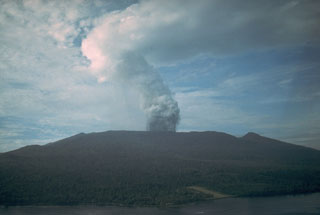Report on Karkar (Papua New Guinea) — November 2000
Bulletin of the Global Volcanism Network, vol. 25, no. 11 (November 2000)
Managing Editor: Richard Wunderman.
Karkar (Papua New Guinea) Rumored eruption on 29 September believed to stem from Ulawun's ash fall
Please cite this report as:
Global Volcanism Program, 2000. Report on Karkar (Papua New Guinea) (Wunderman, R., ed.). Bulletin of the Global Volcanism Network, 25:11. Smithsonian Institution. https://doi.org/10.5479/si.GVP.BGVN200011-251030
Karkar
Papua New Guinea
4.647°S, 145.976°E; summit elev. 1839 m
All times are local (unless otherwise noted)
On 29 September there were reports of light ash fall on the NE coast of Karkar island, and fine sand deposits were found at the bottom of a swimming pool. The ash fall led to the rumor that Karkar volcano had erupted. However, an aerial inspection of the central caldera and Bagiai cone on 1 October showed that no eruptive activity had taken place. Volcanologists believe that the ash most likely originated from an eruption at Ulawun, which, at its peak on 29 September, had an eruption column to 12-15 km altitude. Ash erupted to those heights would have been taken well into the jet stream and could have been transported to Karkar, which is located 600 km to the W (downwind at high altitudes) of Ulawun. There have been no reports of anomalous activity at Karkar since fumarolic gases killed vegetation in September 1997 (BGVN 22:09).
Geological Summary. Karkar is a 19 x 25 km forest-covered island that is truncated by two nested summit calderas. The 5.5 km outer caldera was formed during one or more eruptions, the last of which occurred 9,000 years ago. The steep-walled 300-m-deep, 3.2 km diameter, inner caldera was formed sometime between 1,500 and 800 years ago. Cones are present on the N and S flanks of this basaltic-to-andesitic volcano; a linear array of small cones extends from the northern rim of the outer caldera nearly to the coast. Recorded eruptions date back to 1643 from Bagiai, a pyroclastic cone constructed within the inner caldera, the floor of which is covered by young, mostly unvegetated andesitic lava flows.
Information Contacts: Ima Itikarai, David Lolok, Herman Patia, and Steve Saunders, Rabaul Volcano Observatory (RVO), P.O. Box 386, Rabaul, Papua New Guinea.

